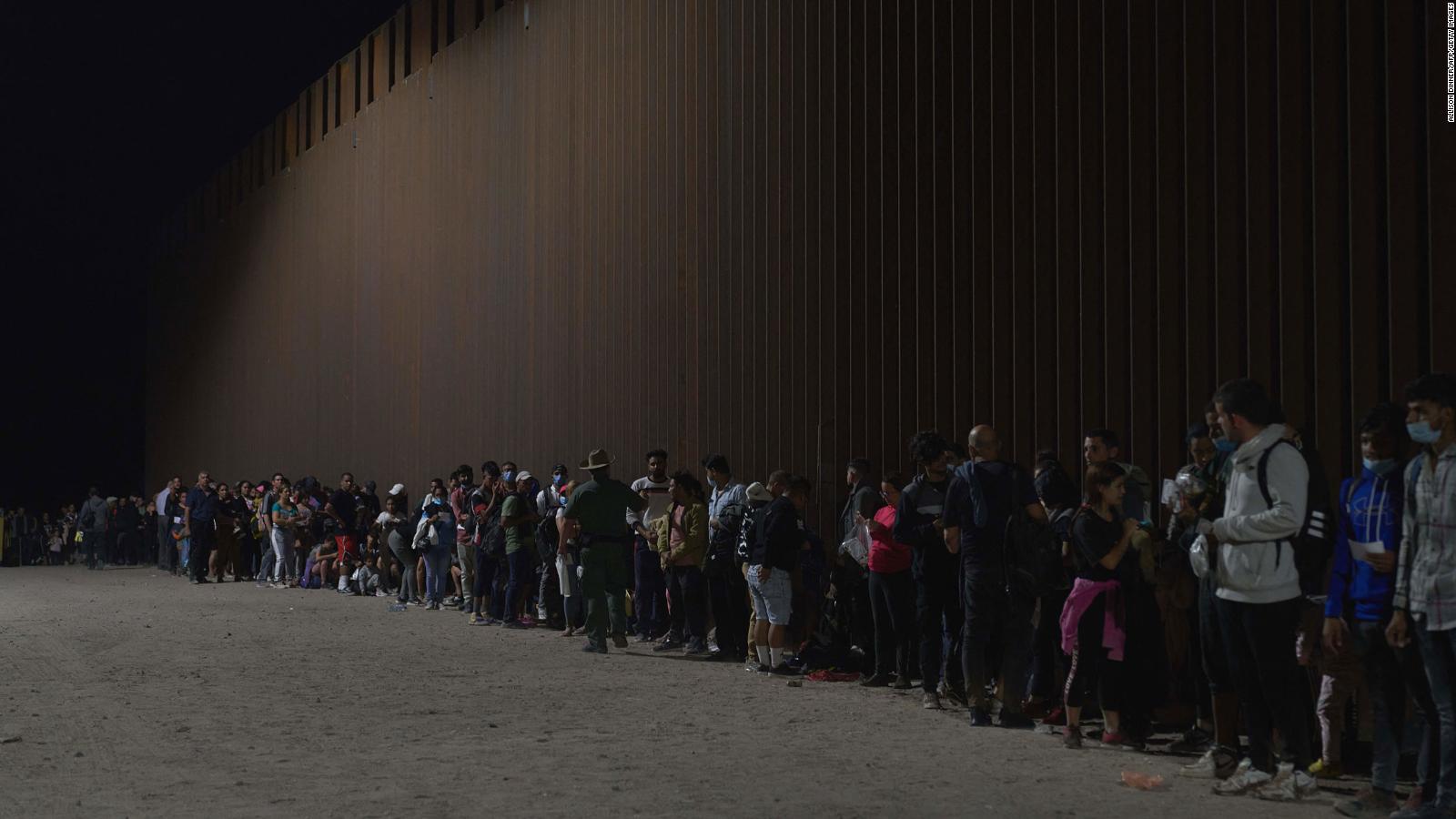(CNN) — One important detail is missing from much of the conversation about the growing number of migrants arriving at the US-Mexico border.
Decades ago, most migrants trying to cross the border between ports of entry were Mexican. A few years ago, the majority came from the Central American countries known as the Northern Triangle: Guatemala, Honduras and El Salvador. But now, according to Border Patrol statistics, the number of people arriving from outside those destinations is increasing, and rapidly.
David Bear calls it a “sea change” and “a new phenomenon that no one is talking about.” Pierre, associate director of immigration studies at the Cato Institute, noted the shift The latest thread on Twitter. He says it’s a detail that reveals what the Biden administration is facing at the border and why the situation is so difficult to resolve.
To better understand this trend, CNN crunched the data. Here’s what we’ve recorded, why this change is so important, why it’s happening, what it’s like on the ground, and what might happen next.
Our Analysis: There is a big shift in who gets to the US-Mexico border. Large numbers of migrants from Mexico and the Northern Triangle continue to travel. But the number of immigrants from other countries represented here in purple has increased significantly.
In 2007, the number of migrants in this “other” category was negligible. But since then, it has grown at an impressive 11,000%, with the largest increase in the last two years.
U.S. Border Patrol encounters showed no other country had more migrants trying to cross the Southwest border in July than Mexico. But so far this fiscal year, for the first time, encounters with immigrants from outside Mexico and the Northern Triangle outnumbered encounters with immigrants from those regions.
A few countries make up the bulk of this growing group of frontiers. The number of U.S. Border Patrol agents encountering migrants from Cuba, Colombia, Nicaragua and Venezuela along the Southwest border has increased dramatically over the past two years.
A word of caution: For this analysis, we used U.S. Customs and Border Protection (CBP) statistics, which include immigrants apprehended and detained, less temporarily at the border, and immigrants immediately deported to their home countries. Mexico. This data provides a better overall picture of who is arriving and what is happening at the border.
But officials have acknowledged that the figure could be higher, as it includes some migrants sent back under the government’s public health policy. “Title 42”Then tried to cross again.
In other words, the same individuals may have been counted multiple times.
This is a problem that particularly affects immigrants from Mexico and the Northern Triangle, who are more likely to be subject to Title 42 restrictions than immigrants from other countries.
This is important because: Doris Meissner, who directs US immigration policy work at the nonpartisan Immigration Policy Institute in Washington, says the surge of additional nationals at the border “complicates policy enforcement at the border even more.”
Over the decades, many border policies have been designed with Mexican immigrants in mind, but deporting people to other countries is more difficult, he says. For example, Title 42 restricts the removal of nationals and their return to their home countries. And chilly diplomatic relations can also affect deportation.
“These people … need different kinds of responses,” says Meissner. “We have by no means established an asylum system to meet the challenge of this change.”
Administration officials say they are working hard to address the root causes of immigration. And President Joe Biden has described him “Hemispheric Challenge”.
But Pierre says the authorities are not doing enough.
“The Biden administration cannot respond to this new reality with the same old playbook,” he said on Twitter. Pierre told CNN that’s exactly what the administration seems to be doing. “It’s the same responses,” he says.
Why it happens: There is no simple reason for this to happen, says Byer.
“Because there are countries represented in that group, there are many answers,” he says.
CBP Commissioner Chris Magnus told CBS News recently It is impossible to pinpoint all the factors that motivate migrants to travel, given the complexity of the situation in their countries of origin. “It’s a very complex set of mechanics,” he said.
Meissner, who was commissioner of the Immigration and Naturalization Service from 1993 to 2000, says the pandemic has played a major role in intensifying economic pressures.
There are other factors at play as well. According to Meissner, the increase in Cubans traveling to the U.S. may be due in part to the new air route between Cuba and Nicaragua. CNN’s Patrick Oppmann reported later Nicaragua Visa requirements for Cubans were lifted, and people began selling their homes “everything in them” and posting ads on the Internet to pay for expensive plane tickets.
Deteriorating economic conditions, food shortages and limited access to health care are driving Venezuelans to leave, and Meissner says the growing Venezuelan community in the U.S. is a counterbalance.
For Colombians and Nicaraguans, he says, economic instability exacerbated by the pandemic is the main driver of migration, but politics also plays a role.
“Increased repression under the Ortega regime, especially during the recent presidential elections, has cemented the belief among many Nicaraguans that the country’s political turmoil will not be resolved anytime soon,” says Meissner.
Those who previously looked at neighboring Costa Rica as a destination are more likely to look elsewhere as job opportunities there dwindle, he says.
Increase in inflation and unemployment Colombia They trigger migration, says Meissner. Social unrest following the 2021 protest wave and political divisions that intensified during the recent presidential election could also influence immigration decisions, he says.
Here’s what it looks like on the ground: This is not something we can see with mere statistics. Both immigrants and Border Patrol agents say they are noticing the change.
Yuma Border Patrol Chief Chris Klemm told CNN’s Priscilla Alvarez last month that his agents are being tested by numerous nationalities crossing the border.
“The countries that we’re getting now, those nationalities that fly in, come to the border, and they have to be processed, there’s so many of them, it’s a challenge for workers,” he said.
Speaking to CNN earlier this year, A Cuban immigrant He described a house in the Mexican desert where he waited with others to cross the border.
One room was full of Cubans, he said. The other was full of people from different countries.
“There were Colombians, Bangladeshis, Venezuelans, Nicaraguans, Haitians,” he said. “Seemed like the whole world.”
What happens next: As with everything related to the border, there is much debate about what authorities should do.
Biden administration officials have repeatedly insisted that the border is not open. But supporters of increasing immigration restrictions argue that the administration’s policies have encouraged more people to try their luck crossing the border illegally. Some, including more than 50% of Republicans, are a step away A recent NPR-Ipsos poll, they believe it is absolutely true that “America is facing an invasion on its southern border.” And some Republican candidates Emphasize this message Ahead of the midterm elections, he promised to do more to crack down on illegal immigration if elected.
Bier and Meissner say the changing composition of immigrants at the border shows that the U.S. immigration system needs an overhaul.
“Many of these people are not eligible for asylum, even though they are fleeing very difficult situations,” says Meissner. “Congress desperately needs to fix immigration laws and create other legal ways to come to America.”
He says countries in the Western Hemisphere must work together and address migration as a shared responsibility.
For now, this trend shows no signs of abating. Pierre and Meissner say they didn’t expect that.
“It’s entirely plausible to think that this could go on for years because we don’t have the infrastructure to push people out as quickly as they arrive,” says Pierre.





